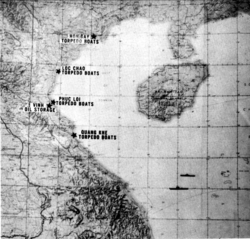Operation Pierce Arrow
Operation Pierce Arrow was a U.S. bombing campaign at the beginning of the Vietnam War.
| Operation Pierce Arrow | |||||
|---|---|---|---|---|---|
| Part of the Vietnam War | |||||
 Targets of Operation Pierce Arrow | |||||
| |||||
| Belligerents | |||||
|
|
| ||||
In response to the Gulf of Tonkin Incident when the destroyers USS Maddox and USS Turner Joy of the United States Navy engaged North Vietnamese ships, sustaining light damage[1] as they gathered electronic intelligence while in the international waters of the Gulf of Tonkin, U.S. President Lyndon B. Johnson ordered Operation "Pierce Arrow" which was conducted on 5 August 1964.[2]
_in_the_South_China_Sea_on_12_August_1964_(USN_1107965).jpg)
The operation consisted of 64 strike sorties of aircraft from the aircraft carriers USS Ticonderoga and USS Constellation against the torpedo boat bases of Hon Gai, Loc Chao, Quang Khe, and Phuc Loi, and the oil storage depot at Vinh. The U.S. lost two aircraft to anti-aircraft fire, with one pilot killed, Lieutenant Richard Sather. Another, Lt. (jg) Everett Alvarez Jr.[3] an A-4 Skyhawk pilot, became the first U.S. Navy Prisoner of War in Vietnam.[4]:56 North Vietnam claimed to have shot down eight U.S. aircraft.[5]
Pilots estimated that the Vinh raid destroyed 10 percent of North Vietnam's entire petroleum storage, together with the destruction of or damage to 29 P-4 torpedo boats or gunboats.[4]:56–7
This was the start of U.S. air operations over North Vietnam and Southeast Asia, attempting to destroy the infrastructure, war material, and military units needed by North Vietnam to prosecute the guerrilla war in the South. The air operations following Pierce Arrow would swell so that by war's end, the United States bombing campaign was the longest and heaviest in history. The 7,662,000 tons of bombs dropped in Southeast Asia during the Vietnam War nearly quadrupled the 2,150,000 tons the U.S. had dropped during World War II.[4]:225
References
- Tim Weiner, Legacy of Ashes: The History of the CIA (New York: Doubleday, 2007), p. 241.
- Robert Bruce Frankum, Like Rolling Thunder: The Air War in Vietnam, 1964-1975. Rowland & Littlefield, 2005), p. 15.
- Interview with Everett Alvarez, 1981
- Clodfelter, Michael (1995). Vietnam in Military Statistics: A History of the Indochina Wars, 1792-1991. McFarland & Company, Inc. ISBN 9780786400270.
- Military History Institute of Vietnam (2002). Victory in Vietnam: A History of the People's Army of Vietnam, 1954–1975. trans. Pribbenow, Merle. University of Kansas Press. p. 132. ISBN 0-7006-1175-4.